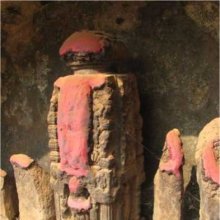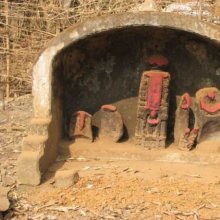Nilagiri, Nila-giri, Nīlagiri: 11 definitions
Introduction:
Nilagiri means something in Buddhism, Pali, Hinduism, Sanskrit, biology. If you want to know the exact meaning, history, etymology or English translation of this term then check out the descriptions on this page. Add your comment or reference to a book if you want to contribute to this summary article.
Images (photo gallery)
In Hinduism
Kavya (poetry)
Source: Shodhganga: The Kavyamimamsa of RajasekharaNīlagiri (नीलगिरि) is the name a locality mentioned in Rājaśekhara’s 10th-century Kāvyamīmāṃsā.—It is one of the Varṣa Mountains of Jamūdvīpa or Asia. This mountain is identified with immediately to the north of the Mahāmeru.

Kavya (काव्य, kavya) refers to Sanskrit poetry, a popular ancient Indian tradition of literature. There have been many Sanskrit poets over the ages, hailing from ancient India and beyond. This topic includes mahakavya, or ‘epic poetry’ and natya, or ‘dramatic poetry’.
Purana and Itihasa (epic history)
Source: archive.org: Puranic EncyclopediaNīlagiri (नीलगिरि).—Name of a mountain in the region called Ilāvṛta of Jambū island. In Ilāvṛta there are three chief mountains called Nīlagiri, Śvetagiri and Śṛṅgavān, and in their middle three Varṣas (regions) called Ramyaka, Hiraṇmaya and Kuru. (Devī Bhāgavata, 8th Skandha).
Source: archive.org: Shiva Purana - English TranslationNīlagiri (नीलगिरि) is another name for the Mountain Nīla, according to the Śivapurāṇa 2.3.37 (“The letter of betrothal is dispatched”).—Note: Nīla or Nīlagiri, “the Blue Mountain” seems to be the Nīlādri or Nīlakūṭa, the name of the “Kāmākhyā hill” according to the Kālikāpurāṇa 79.74 Cf. Śaktisaṅgama-tantra III. 7.?0.

The Purana (पुराण, purāṇas) refers to Sanskrit literature preserving ancient India’s vast cultural history, including historical legends, religious ceremonies, various arts and sciences. The eighteen mahapuranas total over 400,000 shlokas (metrical couplets) and date to at least several centuries BCE.
In Buddhism
Theravada (major branch of Buddhism)
Source: Pali Kanon: Pali Proper NamesSee Nilagalla (2), also Ramanilagiri.
Theravāda is a major branch of Buddhism having the the Pali canon (tipitaka) as their canonical literature, which includes the vinaya-pitaka (monastic rules), the sutta-pitaka (Buddhist sermons) and the abhidhamma-pitaka (philosophy and psychology).
Biology (plants and animals)
Source: Wisdom Library: Local Names of Plants and DrugsNilagiri in the Telugu language is the name of a plant identified with Eucalyptus tereticornis Sm. from the Myrtaceae (Bottlebrush) family. For the possible medicinal usage of nilagiri, you can check this page for potential sources and references, although be aware that any some or none of the side-effects may not be mentioned here, wether they be harmful or beneficial to health.
Source: Google Books: CRC World Dictionary (Regional names)Nilagiri in India is the name of a plant defined with Eucalyptus globulus in various botanical sources. This page contains potential references in Ayurveda, modern medicine, and other folk traditions or local practices It has the synonym Eucalyptus maidenii subsp. globulus (Labill.) J.B. Kirkp..
Example references for further research on medicinal uses or toxicity (see latin names for full list):
· Journal of Ethnopharmacology (2002)
· Cytologia (1985)
· Relation du Voyage à la Recherche de la Pérouse (1799)
· Aspects of Plant Sciences (1989)
· Bot. Journal of the Linnean Society (1975)
· Journal of Ethnopharmacology (2003)
If you are looking for specific details regarding Nilagiri, for example extract dosage, health benefits, pregnancy safety, chemical composition, side effects, diet and recipes, have a look at these references.

This sections includes definitions from the five kingdoms of living things: Animals, Plants, Fungi, Protists and Monera. It will include both the official binomial nomenclature (scientific names usually in Latin) as well as regional spellings and variants.
Languages of India and abroad
Sanskrit dictionary
Source: Cologne Digital Sanskrit Dictionaries: Cappeller Sanskrit-English DictionaryNīlagiri (नीलगिरि).—[masculine] [Name] of a mountain.
Source: Cologne Digital Sanskrit Dictionaries: Monier-Williams Sanskrit-English DictionaryNīlagiri (नीलगिरि):—[=nīla-giri] [from nīla > nīl] m. Name of a mountain, [Catalogue(s)]
[Sanskrit to German]
Sanskrit, also spelled संस्कृतम् (saṃskṛtam), is an ancient language of India commonly seen as the grandmother of the Indo-European language family (even English!). Closely allied with Prakrit and Pali, Sanskrit is more exhaustive in both grammar and terms and has the most extensive collection of literature in the world, greatly surpassing its sister-languages Greek and Latin.
Kannada-English dictionary
Source: Alar: Kannada-English corpusNīlagiri (ನೀಲಗಿರಿ):—
1) [noun] a range of mountains situated between south-eastern parts of Karnāṭaka and forming the border between this state and Tamil Nāḍu.
2) [noun] any of a genus (Eucalyptus) of tall, aromatic, evergreen trees (as Eucalyptus diversicolour, E, globulus, E. citriodora, E. tereticornis, etc.) of Myrtaceae family, bearing pendent leaves and umbels of white, red or pink flowers and valued for their timber, gum.
--- OR ---
Nīḷagiri (ನೀಳಗಿರಿ):—
1) [noun] a range of mountains situated between south-eastern parts of Karnāṭaka and forming the border between this state and Tamil Nāḍu.
2) [noun] any of a genus (Eucalyptus) of tall, aromatic, evergreen trees (as Eucalyptus diversicolour, E, globulus, E. citriodora, E. tereticornis, etc.) of Myrtaceae family, bearing pendent leaves and umbels of white, red or pink flowers and valued for their timber, gum.
Kannada is a Dravidian language (as opposed to the Indo-European language family) mainly spoken in the southwestern region of India.
See also (Relevant definitions)
Starts with: Nilagiri mara, Nilagirikarni, Nilagirikarnika, Nilakiri, Nilakiriccanpakam.
Query error!
Full-text (+19): Nilagirikarnika, Nilagiri mara, Pigakina, Hallippe, Karevettu, Karadaka, Tutavar, Karivettu, Hatippe, Kattuccanpakam, Nilakiriccanpakam, Irula, Karvettu, Malaya, Karki, Todava, Kapura, Anjanadri, Villiyar, Nilagalla.
Relevant text
Search found 15 books and stories containing Nilagiri, Nila-giri, Nīla-giri, Nīḷa-giri, Nīlagiri, Nīḷagiri; (plurals include: Nilagiris, giris, Nīlagiris, Nīḷagiris). You can also click to the full overview containing English textual excerpts. Below are direct links for the most relevant articles:
Jainism in Odisha (Orissa) (by Ashis Ranjan Sahoo)
Jaina Antiquities in Nilagiri (Balasore) < [Chapter 3: Survey of Jaina Antiquities in Odisha]
Jaina Antiquities in Manikchauk (Balasore) < [Chapter 3: Survey of Jaina Antiquities in Odisha]
Jaina Antiquities in Balasore District (Introduction) < [Chapter 3: Survey of Jaina Antiquities in Odisha]
Puranic encyclopaedia (by Vettam Mani)
Temples of Purushottama Kshetra Puri (by Ratnakar Mohapatra)
2. Different Names of the Purushottama-kshetra < [Chapter 1 - Introduction]
12. Sakhi-Gopala (at Satyabadi) < [Chapter 4 - Vaishnavite Temples of Purushottama Kshetra]
Manasollasa (study of Arts and Sciences) (by Mahadev Narayanrao Joshi)
3.1. Mountains and Forests described in the Manasollasa < [Chapter 6 - Manasollasa: the first Encyclopaedia]
Devi Bhagavata Purana (by Swami Vijñanananda)
Padma Purana (by N.A. Deshpande)
Chapter 31 - The account of Śivadūtī < [Section 1 - Sṛṣṭi-khaṇḍa (section on creation)]
Chapter 20 - The Importance of Gaṇḍakī < [Section 5 - Pātāla-Khaṇḍa (Section on the Nether World)]

